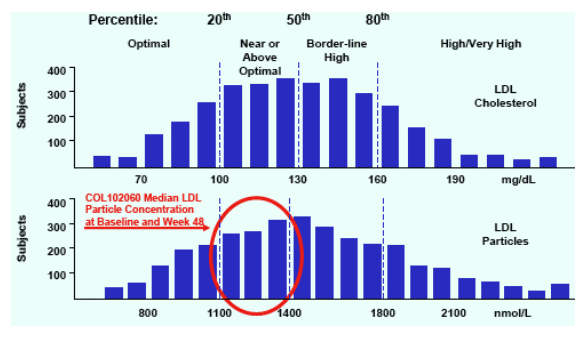I just received the latest bloodwork results after 3 months of the new drug regime.
Back in August I started with 10 mg Crestor (Rosuvastatin), and stopped taking Venlafaxine altogether. No other diet modifications, although I did increase my exercise somewhat back in October. I haven't lost any weight. So how'd I do? All units in mg/dl unless otherwise noted, and I color code the numbers as the Health Diagnostics Lab output does.
These are the measures that everyone gets on a typical lipid panel.
Total Cholesterol dropped from 313 to 196. This is good, but not really that informative. There are better measures of risk.
LDL-C directly measured dropped from 221 to 129. Good, but not surprising because Rosuvastatin suppresses LDL synthesis. The drug is working as expected.
HDL-C dropped from 46 to 38. Bad. But 38 is consistent with my HDL levels from the last few years, so 46 might have been a fluke.
Triglycerides dropped from 292 to 212. Still in the red, but heading in the right direction. Rosuvastatin is supposed to have this effect, as is the Fenofibric acid that I've been on for a few years to no avail.
Here's a longer term view of the triglyceride numbers:
The dotted line is the upper limit of "intermediate risk", and the solid line is the limit of "optimal". So I've never been optimal, and the trend has been pretty alarming when viewed this way! I've been taking Fenofibric acid since that first spike up over 400. It might have helped, except for that one spike up over 500. I also started reducing the carbohydrate in my diet there too. No wonder I have "non-alcoholic steroidal hepatitis". Quoting Dr. D. (my cardiologist), "all that fat has to go somewhere!".
I also get lots of other cool numbers from these detailed labs. First let's take a look at the Lipoprotein particles and Apolipoprotein fractions.
LDL-P (nmol/L) is now measurable! Previously it was just >3500, now it's 2636. To put that in perspective, take a look at this figure:
The bottom histogram is LDL-P; even my current number is in the top-most bar of that figure. Before it wasn't even on the graph. Some folks think this number is much more important than the LDL-C number above. Dr. D seems to be paying attention to this number, and it's why I was willing to start taking a statin again.
sdLDL-C (that's Small and Dense) down from 54 to 35, but it has just dropped in line with the total LDL fraction because the percentage sdLDL hasn't really changed from 25 to 27. The slight increase is something to watch, as small & dense LDL particles are the real bad guys.
HDL-P (nmol/L) stayed about the same, from 33.9 to 35.1, but the HDL2-C fraction decreased from 12 to 5. HDL2 is the subset of HDL that is thought to be most protective from CHD. The decrease is real, not just a function of a decrease in total HDL.
Apolipoprotein B decreased from 177 to 110, while apolipoprotein A increased slightly from 112 to 117. These molecules are the protein components of LDL and HDL respectively (I think ... based on wikipedia reading, but the numbers aren't adding up for me). The goal is to have the ratio of B:A less than 0.6. I've gone from 1.58 to 0.94, so headed in the right direction. Not sure how this is different from looking at ratios of HDL with other cholesterol fractions.
The last number from the first page of results that has changed is hs-CRP (mg/L) which changed from 3.7 to 1.9. C-reactive protein is an index of inflammation. Inflammation is bad, in case you missed the memo! The drop could be due to the statin; statins are known to have anti-inflammatory effects. Or it could just be a fluke.
So, many things are better, some things are worse (HDL). That's alot of numbers to digest. What to do? Well, how about cranking up them drugs some more ... Crestor to 20 mg/day, and a new one for me, Colestipol. Colestipol acts in the gut by binding to cholesterol and preventing it from being taken up into the blood. This works because cholesterol synthesized by the liver goes into the bile, which is dumped into the gut, and then taken up into the blood from there.
What I'd really like to do is calculate my risk of a coronary event. More about that in a future post.
Subscribe to:
Post Comments (Atom)





No comments:
Post a Comment